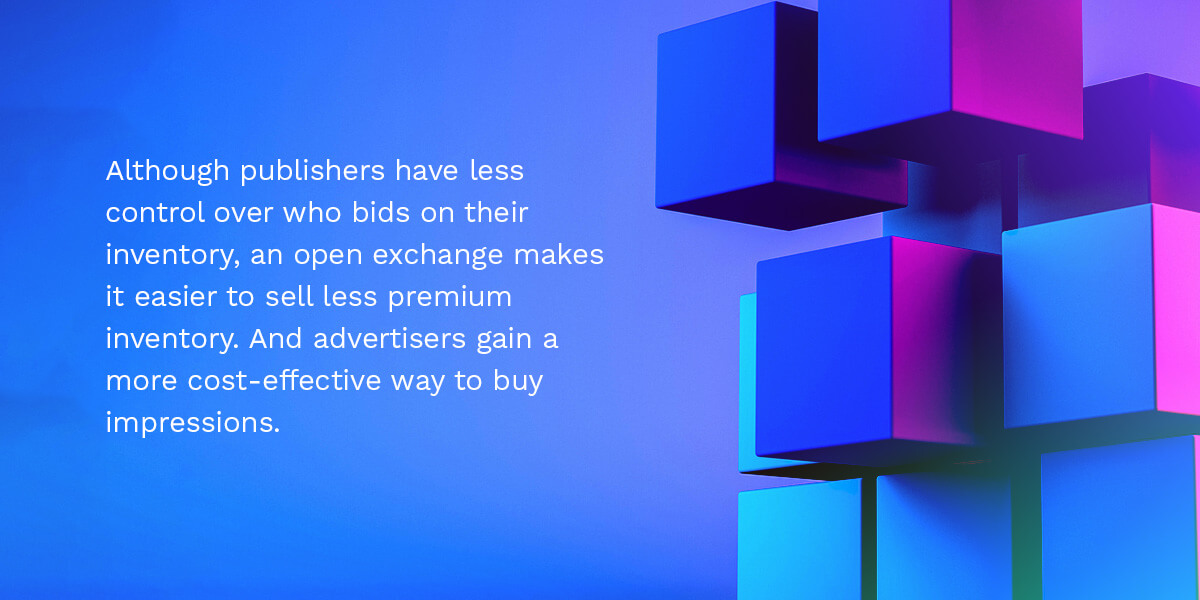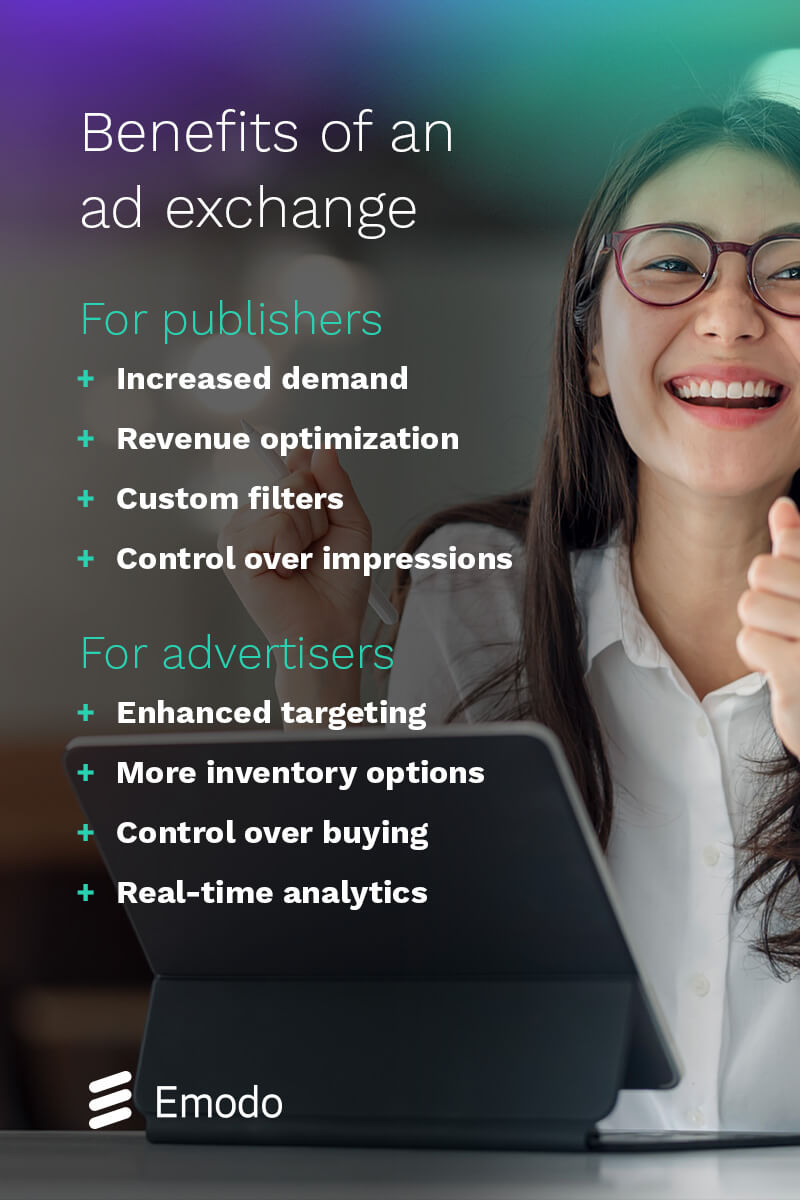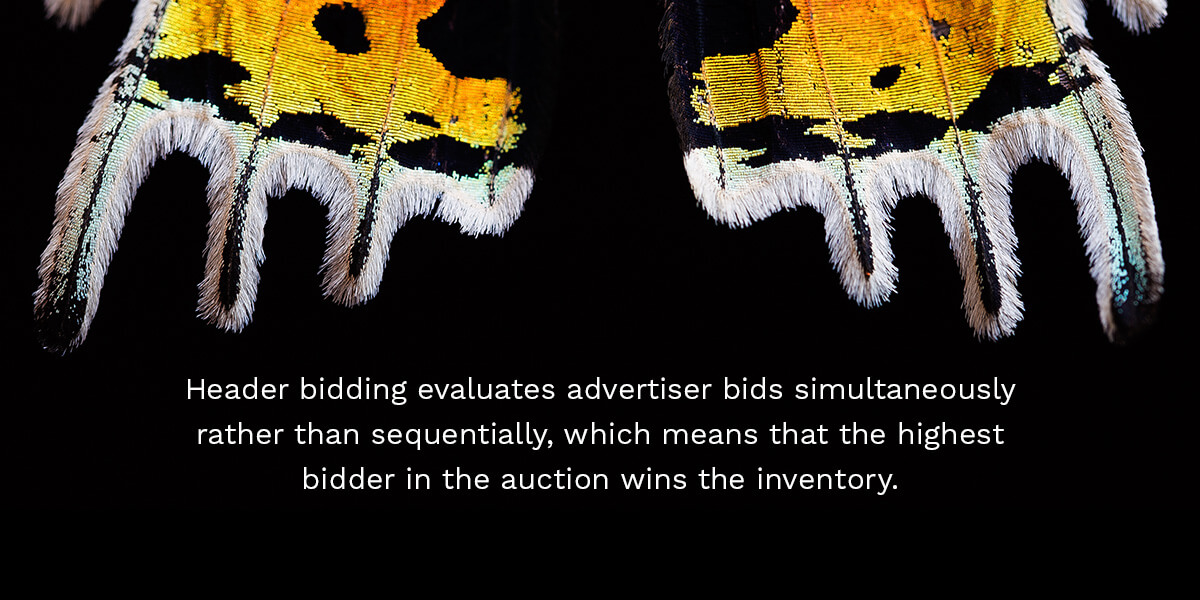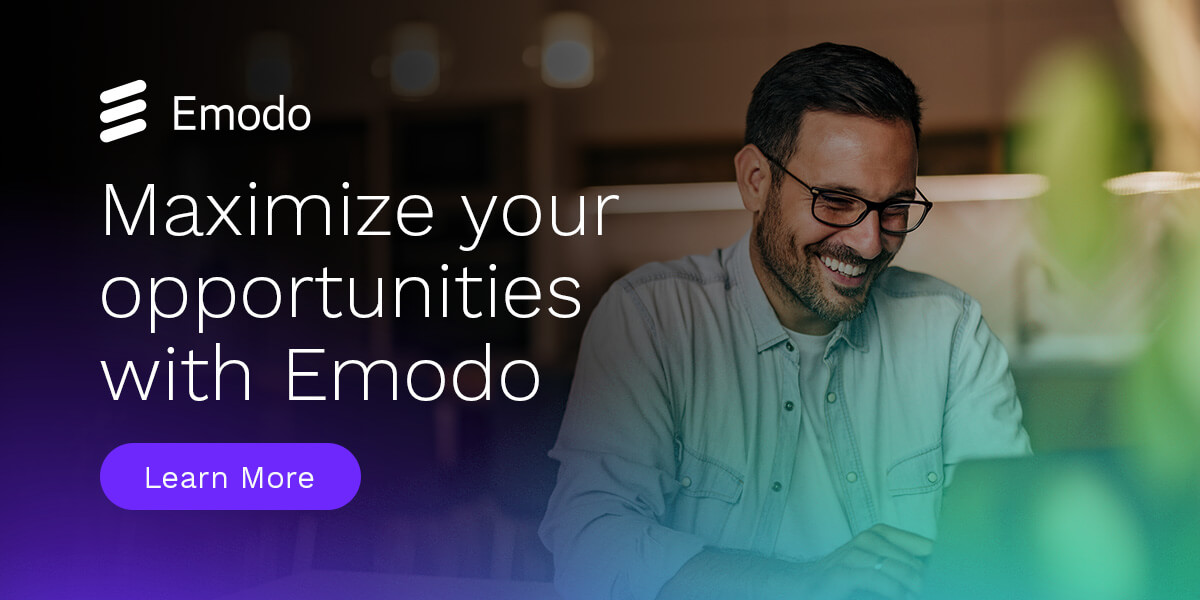Programmatic ad exchange platforms are a vital part of the digital advertising ecosystem. But what is an ad exchange, and how does it function? This comprehensive guide will answer all your questions so you can determine whether working with an ad exchange is right for your brand.
What is an ad exchange?
An ad exchange is a digital marketplace where publishers and advertisers trade inventory. This marketplace uses a rapid, automated auction process called real-time bidding (RTB) to determine which advertisers win impressions.
Before programmatic advertising, advertisers and publishers would manually negotiate deals that would last a specified period of time. Automated platforms like ad exchanges speed up the digital media buying process by eliminating time-consuming negotiations and allowing publishers to rapidly sell individual impressions.
Typically, advertisers and publishers connect to ad exchanges through the following platforms:
- Demand-side platform (DSP): A DSP is an automated software program advertisers use to scan ad exchanges for inventory and place bids on the impressions they want.
- Supply-side platform (SSP): Publishers use SSPs to automatically sell ad space through ad exchanges.
Ad exchanges benefit everyone by enabling advertisers to reach larger audiences and helping publishers find the right ads for their websites — a win for both parties.
Open ad exchange
Also known as an open marketplace or an open market, an open ad exchange is a specific type of deal within an ad exchange. Much like a bazaar or yard sale, it’s open to everyone, which means almost any buyer can purchase inventory — this is totally different from a private marketplace (PMP) or preferred deal, where publishers directly choose who they sell to.
While publishers have less control in open auctions, this openness also helps publishers by letting them generate more demand for their inventory, which means they can sell at a higher price. It also makes open exchanges more transparent than other types of media buying platforms, like ad networks.
How do ad exchanges work?
Here’s a quick rundown of how the ad exchange process usually works:
- When someone visits a website, the publisher sends an automated request to the ad exchange.
- The exchange checks which impressions are available and launches an RTB auction for that space.
- Advertisers or DSPs bid on the impression.
- The RTB algorithm evaluates each bid and awards the impression to the highest bidder.
- The winning ad appears on the page.
It’s important to note that RTB algorithms process bids sequentially in the order of an advertiser’s perceived value to the publisher. The most valuable buyers are first in line, and the algorithm goes through each until one hits the publisher’s floor price. Even if a low-priority buyer’s bid exceeds the floor price, the auction will end if a high-priority buyer meets the floor price.
Examples of ad exchanges
There are many different ad exchanges to choose from. You may have heard of some of these ad exchange platforms:
- Google Ad Exchange (AdX): Previously known as the DoubleClick Ad Exchange, Google’s platform provides solutions for those with Google Ad Manager accounts and AdX access.
- Xandr: AT&T’s ad exchange and SSP, formerly named AppNexus.
- OpenX: A programmatic advertising company and ad-serving platform that combines RTB with various video ad networks and SSPs.
- Magnite: Formerly an SSP named Rubicon Project, Magnite is a global programmatic ad exchange offering solutions for both publishers and advertisers.
- Emodo Exchange: Our intelligent ad exchange integrates with our DSP and SSP to provide a seamless connection between verified advertisers and publishers.
Choosing the right ad exchange for your brand is important for several reasons. It connects advertisers with publishers that match their brand, helps keep costs low and prevents ad fraud.
You’ll want to look for ad exchanges that comply with Interactive Advertising Bureau (IAB) ad verification guidelines, as these exchanges will be safer to work with than others. You can also leverage multiple exchanges simultaneously to diversify your ad-buying strategy.
Open ad exchange vs. private marketplace (PMP)
A private ad exchange, or PMP, is an exclusive programmatic auction. The publisher — usually a well-known site or app with premium inventory — has total control over the advertisers they sell to. Advertisers must receive a virtual invitation called a Deal ID to be eligible to participate in the PMP. Once the publisher has chosen all their potential buyers, the process works like standard RTB auctions.
Using a PMP can benefit advertisers who want to target highly specific audiences. It also provides access to high-quality inventory unavailable in most open exchanges. However, this premium inventory also means publishers can charge higher prices for it — which is the biggest advantage of PMPs for publishers.
Advertisers need to develop a business relationship with a publisher in order to gain an invite to a PMP. Additionally, the exclusivity of private platforms can limit demand.
Ultimately, the choice between PMP and open ad exchange will vary depending on your goals. Well-known publishers with premium inventory, such as established news sites, usually sell through PMPs because there is already existing demand for their ad space.

On the other hand, an open exchange is a great tool for maximizing efficiency for both parties. Although publishers have less control over who bids on their inventory, an open exchange makes it easier to sell less premium inventory. And advertisers gain a more cost-effective way to buy impressions.
Ad exchange vs. ad network
While ad exchanges and ad networks may sound similar, they use completely different business models with distinct features and advantages.
Ad networks buy ad inventory in bulk from multiple publishers or ad exchanges, which they mark up and sell to advertisers for a profit. That’s how they make their money — they buy inventory at the lowest possible price and resell it at the highest possible price.
But then how do ad exchanges make money? Instead of marking up inventory to make a profit, ad exchanges take a percentage of the money exchanged in RTB auctions. As a result, they benefit from publishers selling inventory at higher prices.
Some of the other differences between the two include:
- Transparency: Ad exchanges are generally more transparent than ad networks because they enable advertisers to see exactly what impressions are selling for. Similarly, ad exchanges give publishers greater control with custom settings — in an ad network, publishers have no way of knowing who will buy their inventory.
- Price stability: Inventory prices tend to fluctuate in ad exchanges because of the RTB algorithms. Ad networks, on the other hand, offer fixed prices.
- Efficiency: Unlike ad exchanges, ad networks do not use automated auctions to sell impressions. This lack of automation means buying and selling inventory through ad networks takes longer than it does in ad exchanges.
- Targeting: Ad networks handle a lot of impressions, so they break down their available inventory into specific segments for advertisers with specific audiences. Advertisers can do something similar in ad exchanges by setting custom demographic filters.
Incorporating both ad networks and ad exchanges into your buying or selling strategy can help you get the best of both worlds. For example, publishers can use ad exchanges to sell inventory that they know will be worth more while selling lower-quality inventory to ad networks.
Ad exchange vs. supply-side platform (SSP)
An SSP is an automated software platform that lets publishers sell digital inventory through ad networks and exchanges. It’s basically the publisher’s equivalent of a DSP.
Ad exchanges connect DSPs and SSPs, enabling them to buy and sell digital ad impressions. SSPs use similar technology, but it serves a different purpose. Publishers usually use SSPs to connect to multiple ad exchanges simultaneously, which helps them increase competition for impressions and drive up revenue.
Essentially, ad exchanges aggregate impressions for advertisers, while SSPs aggregate ad exchanges for publishers.
Benefits of an ad exchange
One of the biggest benefits for both parties is the efficiency of using an ad exchange to buy and sell ad impressions. Ad exchanges use RTB algorithms to automate the digital media buying process in a matter of milliseconds — that’s lightyears ahead of the traditional back-and-forth negotiations.
Ad exchanges also provide unique benefits to each party, such as the following.

For publishers
Here are some of the biggest advantages of using ad exchanges for publishers:
- Increased demand: Open ad exchanges have more participants than PMPs or ad networks, so publishers have more opportunities to sell and a greater ability to generate revenue.
- Revenue optimization: Publishers can set minimum cost per milles (CPMs) on their inventory to ensure they get a fair price. Contrast that to ad networks, which purchase impressions at the lowest possible cost.
- Custom filters: Ad filtering and blocking settings allow publishers to be more selective over who purchases their inventory, which can help prevent sensitive or damaging content or competitor advertisements from appearing on their page.
- Control over impressions: Publishers have complete control over the ad formats and styles they want on their pages as well as when and where these ads will appear.
For advertisers
Here are a few of the ways advertisers can benefit from using an ad exchange:
- Enhanced targeting: Ad exchanges give advertisers the power to choose which audiences they target. This ability also lets advertisers retarget specific audiences across multiple exchanges.
- More inventory options: Advertisers can choose from a wider inventory range, allowing them to get the most out of their campaign budget.
- Control over buying: Advertisers can set which publishers they want to buy from, how often their ad appears to the same users and how much they’re willing to pay for impressions.
- Real-time analytics: Advertisers can monitor and optimize ad performance in real time to maximize ROI.
The future of ad exchanges
Ad exchanges are evolving to meet the changing needs of the online advertising industry, with new trends and technologies shaping their future.
Privacy regulations
With Google planning to phase out invasive third-party cookies by 2024, ad exchanges will need to change their targeting strategies. Traditionally, ad exchanges would use third-party cookies to track users’ browsing habits across the internet from a publisher’s site.
However, third-party cookies and device IDs pose serious user privacy concerns. Many third-party cookies collect sensitive information like user email addresses without the user’s knowledge — and if cybercriminals gain access to this information, they can also see geo-contextual information, sites that the user has interacted with and more.
First-party cookies are not invasive because they only track user behavior on the publisher’s site. Ad exchanges will need to incorporate first-party cookies to keep up with industry trends — a recent industry survey from the IAB revealed that first-party cookies will be a major focus area for digital advertisers in 2023.
Header bidding

The recent rise of header bidding — also known as advance bidding or pre-bidding — could also dramatically change how ad exchanges work. Header bidding evaluates advertiser bids simultaneously rather than sequentially, which means that the highest bidder in the auction wins the inventory.
Here’s how it works. Publishers place a piece of code in a page’s header, allowing DSPs to begin bidding before the ad server callout. Publishers can spread this auction across multiple ad exchanges, which creates a single unified auction and increases competition for that space.
On the advertiser side, the header bidding algorithm evaluates all advertisers and DSPs simultaneously rather than sequentially — regardless of an advertiser’s priority in the server, the algorithm processes all the bids at once. Essentially, header bidding makes the bidding process fairer for advertisers while enabling the publisher to drive up the price per impression.
Artificial intelligence and machine learning
Many ad exchanges already use some AI functionalities, and we’re likely to see more of these tools due to the growing popularity of tech like ChatGPT. For example, smart algorithms can automatically adapt creative resolutions so ads fit popular placement formats. This expands opportunities for advertisers, which can, in turn, help increase demand for inventory on the publisher side.
AI can also help advertisers maximize their return on investment (ROI) by analyzing their ad data and identifying the best impressions for their campaigns. It can also reveal new advertising opportunities for advertisers by using machine learning (ML) to learn from past campaign performance metrics.
Finally, AI could help in fraud prevention. Ad fraud usually occurs when bots or scammers posing as legitimate publishers sell fake impressions to unsuspecting advertisers through RTB — and their ads are displayed to bots rather than real people. Ad exchanges with AI capabilities can detect fraudulent behaviors that humans might miss, protecting exchange participants from losing money.
Maximize your opportunities with Emodo
If you’re looking for a better way to buy and sell digital media, you’ve come to the right place.
Emodo Activate, our DSP, empowers advertisers to create more memorable experiences through richer, smarter ad formats such as Emodo Adapt. And the targeting solutions in Emodo Audiences enable advertisers to meet audiences where they are without compromising consumer privacy.
Publishers can gain seamless access to Emodo Exchange through Emodo Access, our SSP. By leveraging automatic creative enrichment capabilities, Emodo Access enables publishers to optimize ad rendering and maximize the value of their inventory.
Connect with us today to learn more. We look forward to hearing from you!
MORE LIKE THIS



